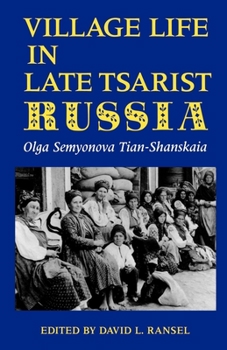Village Life in Late Tsarist Russia
Select Format
Select Condition 
Book Overview
" . . . a marvelous source for the social history of Russian peasant society in the years before the revolution. . . . The translation is superb." --Steven Hoch
" . . . one of the best ethnographic portraits that we have of the Russian village. . . . a highly readable text that is an excellent introduction to the world of the Russian peasantry." --Samuel C. Ramer
Village Life in Late Tsarist Russia provides a unique firsthand portrait...
Format:Paperback
Language:English
ISBN:0253207843
ISBN13:9780253207845
Release Date:May 1993
Publisher:Indiana University Press
Length:208 Pages
Weight:0.45 lbs.
Dimensions:0.4" x 5.5" x 8.5"
Customer Reviews
2 ratings
A 19th Century Russian peasant's view of the world. (details)
Published by Thriftbooks.com User , 14 years ago
First and foremost, this book is an outstanding anthropological achievement by the original author, Olga Semyonova Tian-Shanskaia, who died a few years prior to its actual publication in 1914. In spite of the longwinded and boring (but still informative) introduction by Editor David L. Ransel, the core of Tian-Shanskaia's writing and her straightforward approach to the [then] young science of anthropology shines through to make this account quite a fascinating read for nearly anyone. I don't mean treat Ransel harshly but, as a university professor carrying out a funded project, he was clearly forced to swallow a certain amount of input from associates and other scholarly drones. I'm certain that this 20-page Introduction would have come off as infinitely more palatable and devoid of academic baggage had Ransel just sat down and written it from his clear knowledge of the author and from his heart -- in other words, there were too many cooks in the kitchen. But this is only a mild critique of the work and the fact that Ransel included a nice black-and-white photo of the author as well as a map of the study area at the very outset balances out the other shortcomings. I also found Ransel's footnotes, throughout the book, to be quite enlightening. Chiefly, the reader gets a view of the post-emancipation Russian serf world from Tian-Shanskaia's aggregate fictional "Ivan". She was pretty much forced to eavesdrop on village gossip as she painted pictures in these villages to garner mostly anecdotal information about life among the peasants. In any case, we discover what Ivan liked and disliked, how his life was pre-ordained from even before his birth until his death including his infancy, adolescence, married life, and his life as a parent. The account includes discussion of social interaction, economics, and the many ominous labors which every peasant had to bear in order to survive. Death by accident, disease, or homicide was clearly a daily possibility for Russia's muzhiks. This is a nicely-bound college text-type paperback, 176 pages in length. It reads as smoothly as fiction and I highly recommend it. I should also add that if you read and enjoy this book, you'll probably also like Lyeskov's fictional Enchanted Wanderer.
On the ground in pre-Revolutionary Russian villages
Published by Thriftbooks.com User , 15 years ago
I do not possess enough professional knowledge to critique the accuracy of the work or quality of compilation. However, as a professional Russian translator who has traveled in Russia and continues to study its culture, I found this a fascinating look by an early ethnographer into daily life in Russian villages. The translation is clear and very readable, well-supplemented with notes and many photographs. The authors compiled this book from a great deal of related documents left by Tian-Shanskaya, and made use of other related ethnographic work. They include explanations of the sources where appropriate, which gives the book and added value: the reader gets a sense of how this unified book of her work was patched together. They give a good overview of the contemporary context of her work and of the 'peasant question'. In addition, they explain what they perceive as the influence of her own ideals and values upon the interpretation of peasant behavior, and compare it to later theories (for example, where she reports chronic 'squandering' of surpluses, they compare it to later theories of the peasants' perception of a limited world of resources and the importance of investing in status within the social network of the village). The book contains many overheard conversations and remarks among peasants. All in all, a pearl of a book, in my opinion.




